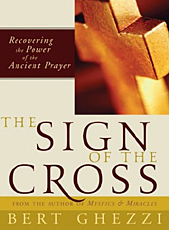"In all our travels and movements, in all our coming in and going out, in putting on our shoes, at the bath, at the table, in lighting our candles, in lying down, in sitting down, whatever employment occupies us, we mark our foreheads with the sign of the cross." These words are from Tertullian, a Christian theologian writing at the turn of the third century. In this helpful resource, Bert Ghezzi, a Catholic writer, discusses the meaning of making the sign of the cross according to Scripture, Church teaching, the writings of the Church Fathers, the testimony of the saints, theology books, and his own personal experience. He has identified six dynamic truths about this practice — It is an opening to God, a renewal of baptism, a mark of discipleship, an acceptance of suffering, a defense against the devil, and victory over self-indulgence.
Most of us have seen Catholics enter a church, dip their fingers into the holy water, and make a sign of the cross. Ghezzi points out that there are many other occasions when it would be appropriate to use this ancient ritual: upon waking up, before eating, when driving the children to school, at the start the workday, when responding to e-mail, when shopping, when relaxing with family, and upon going to bed. Martin Luther wrote: "As soon as you get out of bed in the morning, you should bless yourself with the sign of the Holy Cross and say: 'May the will of God, the Father, the Son and the Holy Spirit be done! Amen.' ''
Many Christians use the sign of the cross to bless others or to bless things. Some like using a prayer with it, such as "Our help is in the Name of the Lord." Twenty-first century Christians make the sign of the cross in a variety of ways — with one finger, two fingers, three fingers, or an open hand. According to Ghezzi, all who sign themselves with faith are presenting themselves to the Lord.
Back to reading a full review of this book.
